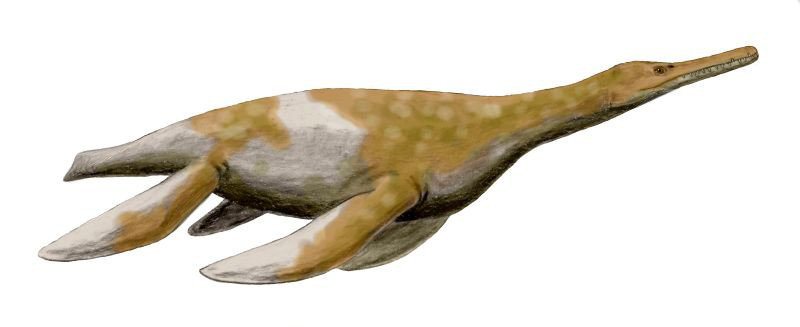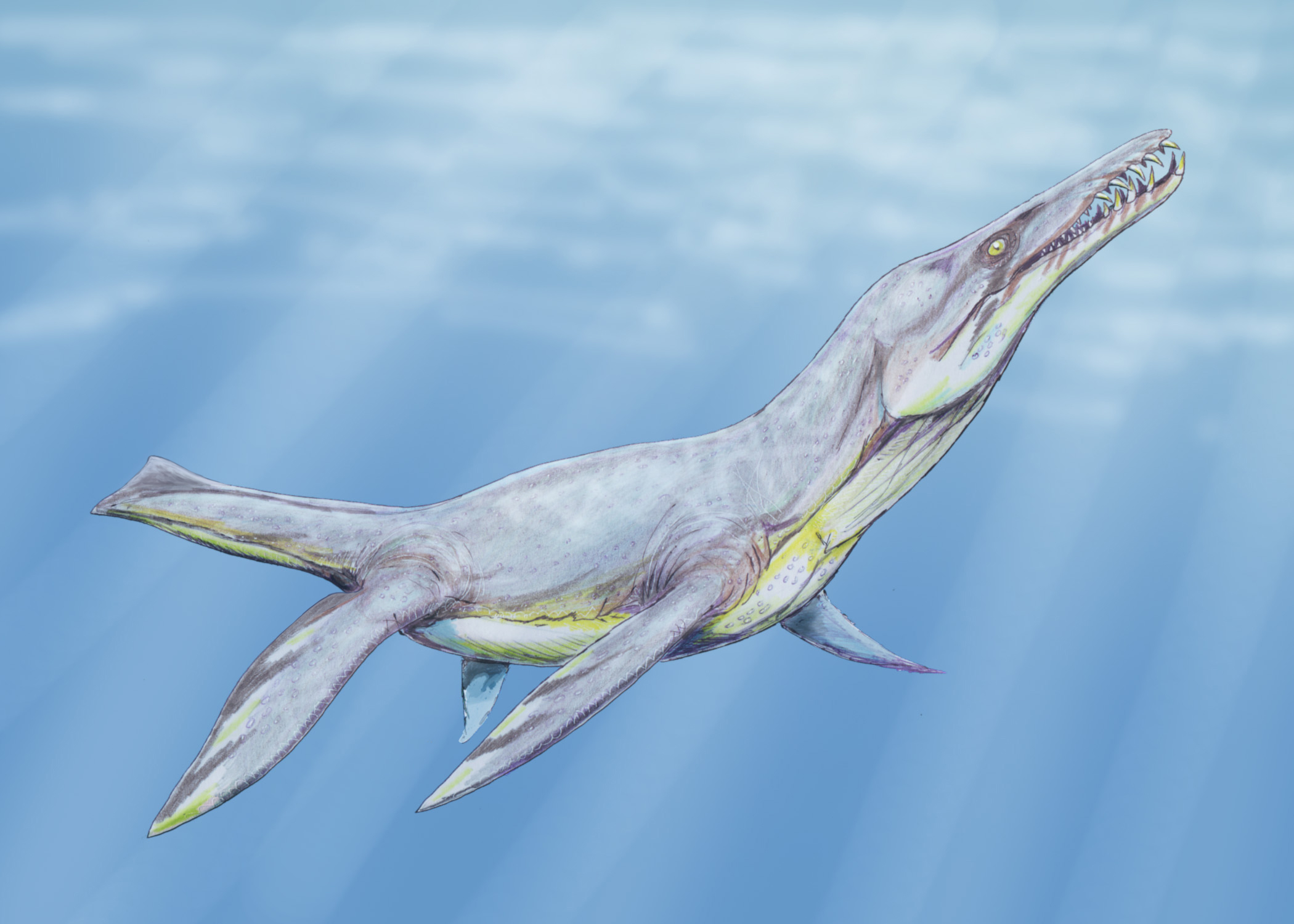|
Polycotylidae
Polycotylidae is a family of plesiosaurs from the Cretaceous, a sister group to Leptocleididae. Polycotylids first appeared during the Albian stage of the Early Cretaceous, before becoming abundant and widespread during the early Late Cretaceous. Several species survived into the final stage of the Cretaceous, the Maastrichtian. With their short necks and large elongated heads, they resemble the pliosaurs, but closer phylogenetic studies indicate that they share many common features with the Leptocleididae and Elasmosauridae. They have been found worldwide, with specimens reported from New Zealand, Australia, Japan, Morocco, the US, Canada, Eastern Europe, and South America. Phylogeny Cladogram A cladogram (from Greek ''clados'' "branch" and ''gramma'' "character") is a diagram used in cladistics to show relations among organisms. A cladogram is not, however, an evolutionary tree because it does not show how ancestors are related to d ... after Albright, Gillette and Tit ... [...More Info...] [...Related Items...] OR: [Wikipedia] [Google] [Baidu] |
Mauriciosaurus
''Mauriciosaurus'' (meaning "Mauricio ernández Garza'sreptile") is a genus of polycotylid plesiosaur from the Late Cretaceous of Mexico. It contains a single species, ''M. fernandezi'' (also named after Fernández Garza), described in 2017 by Eberhard Frey and colleagues from a single well-preserved juvenile specimen about long. Morphologically, it is overall most similar to the polycotyline polycotylids '' Trinacromerum'' and ''Dolichorhynchops''. However, several features separate ''Mauriciosaurus'' from all other polycotylids, warranting the naming of a new genus. These include the sophisticated pattern of ridges on the bottom of the parasphenoid bone on its palate; the narrow openings in the palate bordered by the pterygoid bones; the lack of perforations in the surface of the coracoid; and the highly unusual arrangement of gastralia, or belly ribs, which is only otherwise seen in the non-polycotylid ''Cryptoclidus''. Partially as a consequence of the oxygen-poor environm ... [...More Info...] [...Related Items...] OR: [Wikipedia] [Google] [Baidu] |
Elasmosauridae
Elasmosauridae is an extinct family of plesiosaurs, often called elasmosaurs. They had the longest necks of the plesiosaurs and existed from the Hauterivian to the Maastrichtian stages of the Cretaceous, and represented one of the two groups of plesiosaurs present at the end of the Cretaceous alongside Polycotylidae. Their diet mainly consisted of crustaceans and molluscs. Description The earliest elasmosaurids were mid-sized, about . In the Late Cretaceous, elasmosaurids grew as large as , such as '' Styxosaurus'', ''Albertonectes'', and '' Thalassomedon''. Their necks were the longest of all the plesiosaurs, with anywhere between 32 and 76 (''Albertonectes'') cervical vertebrae. They weighed up to several tons. Classification Early three-family classification Though Cope had originally recognized ''Elasmosaurus'' as a plesiosaur, in an 1869 paper he placed it, with ''Cimoliasaurus'' and ''Crymocetus'', in a new order of sauropterygian reptiles. He named the group Streptos ... [...More Info...] [...Related Items...] OR: [Wikipedia] [Google] [Baidu] |
Dolichorhynchops
''Dolichorhynchops'' is an extinct genus of polycotylid plesiosaur from the Late Cretaceous (early Turonian to late Campanian stage) of North America, containing three species, ''D. osborni'', ''D. bonneri'' and ''D. tropicensis'', as well as a questionably referred fourth species, ''D. herschelensis''. ''Dolichorhynchops'' was an oceangoing prehistoric reptile. Its Greek generic name means "long-nosed face". Discovery and species ''D. osborni'' The holotype specimen of ''Dolichorhynchops osborni'' was discovered in the upper Smoky Hill Chalk Logan County, Kansas, by George F. Sternberg, as a teenager, in around 1900. The remains were collected by him and his father, Charles H. Sternberg, and then sold to the University of Kansas (Lawrence, Kansas). KUVP 1300 was prepared and mounted by H.T. Martin under the supervision of Dr. Samuel Wendell Williston, who described and named it in 1902. A more detailed description and photographs were provided by ). The specimen has been on dis ... [...More Info...] [...Related Items...] OR: [Wikipedia] [Google] [Baidu] |
Dolichorhynchops Bonneri
''Dolichorhynchops'' is an extinct genus of polycotylid plesiosaur from the Late Cretaceous (early Turonian to late Campanian stage) of North America, containing three species, ''D. osborni'', ''D. bonneri'' and ''D. tropicensis'', as well as a questionably referred fourth species, ''D. herschelensis''. ''Dolichorhynchops'' was an oceangoing prehistoric reptile. Its Greek generic name means "long-nosed face". Discovery and species ''D. osborni'' The holotype specimen of ''Dolichorhynchops osborni'' was discovered in the upper Smoky Hill Chalk Logan County, Kansas, by George F. Sternberg, as a teenager, in around 1900. The remains were collected by him and his father, Charles H. Sternberg, and then sold to the University of Kansas (Lawrence, Kansas). KUVP 1300 was prepared and mounted by H.T. Martin under the supervision of Dr. Samuel Wendell Williston, who described and named it in 1902. A more detailed description and photographs were provided by ). The specimen has been on disp ... [...More Info...] [...Related Items...] OR: [Wikipedia] [Google] [Baidu] |
Polycotylus
''Polycotylus'' is a genus of plesiosaur within the family Polycotylidae. The type species is ''P. latippinis'' and was named by American paleontologist Edward Drinker Cope in 1869. Eleven other species have been identified. The name means 'much-cupped vertebrae', referring to the shape of the vertebrae. It lived in the Western Interior Seaway of North America toward the end of the Cretaceous. One fossil preserves an adult with a single large fetus inside of it, indicating that ''Polycotylus'' gave live birth, an unusual adaptation among reptiles. History Edward Drinker Cope named ''Polycotylus'' from the Niobrara Formation in Kansas in 1869. The holotype bones from which he based his description were fragmentary, representing only a small portion of the skeleton. A more complete skeleton was later found in Kansas and was described in 1906. A nearly complete skeleton was found in 1949 from the Mooreville Chalk Formation in Alabama, but was not described until 2002. A new species, ... [...More Info...] [...Related Items...] OR: [Wikipedia] [Google] [Baidu] |
Plesiosaur
The Plesiosauria (; Greek: πλησίος, ''plesios'', meaning "near to" and ''sauros'', meaning "lizard") or plesiosaurs are an order or clade of extinct Mesozoic marine reptiles, belonging to the Sauropterygia. Plesiosaurs first appeared in the latest Triassic Period, possibly in the Rhaetian stage, about 203 million years ago. They became especially common during the Jurassic Period, thriving until their disappearance due to the Cretaceous–Paleogene extinction event at the end of the Cretaceous Period, about 66 million years ago. They had a worldwide oceanic distribution, and some species at least partly inhabited freshwater environments. Plesiosaurs were among the first fossil reptiles discovered. In the beginning of the nineteenth century, scientists realised how distinctive their build was and they were named as a separate order in 1835. The first plesiosaurian genus, the eponymous ''Plesiosaurus'', was named in 1821. Since then, more than a hundred valid ... [...More Info...] [...Related Items...] OR: [Wikipedia] [Google] [Baidu] |
Eopolycotylus
''Eopolycotylus'' is an extinct genus of Polycotylid plesiosaur known from the Cenomanian-age Tropic Shale of Utah.L. B. Albright, D. D. Gillette, and A. L. Titus. 2007. Plesiosaurs from the Upper Cretaceous (Cenomanian-Turonian) Tropic Shale of southern Utah, part 2: Polycotylidae. Journal of Vertebrate Paleontology 27(1):41-58 See also * Timeline of plesiosaur research * List of plesiosaurs This list of plesiosaurs is a comprehensive listing of all genera that have ever been included in the order Plesiosauria, excluding purely vernacular terms. The list includes all commonly accepted genera, but also genera that are now considered inv ... References Fossil taxa described in 2007 Late Cretaceous plesiosaurs of North America Polycotylids Sauropterygian genera {{plesiosaur-stub ... [...More Info...] [...Related Items...] OR: [Wikipedia] [Google] [Baidu] |
Serpentisuchops
''Serpentisuchops'' (meaning "snaky crocodile-face") is a genus of polycotylid plesiosaur from the late Cretaceous Pierre Shale of Wyoming, United States. The genus contains a single species, ''S. pfisterae'', known from a partial skeleton. Discovery and naming The holotype specimen, GPM5001, was found at the Old Woman Anticline in the upper Pierre Shale in 1995 and brought to the collection of the Paleon Museum in Glenrock. This locality is dated to the lower Maastrichtian age of the upper Cretaceous period, around 69.59 to 70.00 million years old. It consists of a partial skull, lower jaw, and vertebral column, in addition to the left ilium and pubis. In 2022, ''Serpentisuchops pfisterae'' was described as a new genus and species of polycotylid plesiosaur by Walter S. Persons, Hallie P. Street, and Amanda Kelley based on these remains. The generic name, "''Serpentisuchops''", is derived from the Latin words "serpent", meaning "snake", and "suchus" meaning "crocodile" ... [...More Info...] [...Related Items...] OR: [Wikipedia] [Google] [Baidu] |
Plesiopleurodon
''Plesiopleurodon'' (/ˌpliːsiəˈplʊərədɒn/; el, plesios, meaning “near to”, ''pleuro'', meaning “side”, and ''don'', meaning “tooth”) is an extinct genus of Mesozoic marine reptiles, belonging to Sauropterygia, known from the Late Cretaceous of North America. It was named by Kenneth Carpenter based on a complete skull with a mandible, cervical vertebra, and a coracoid. In naming the specimen, Carpenter noted "Of all known pliosaurs, ''Plesiopleurodon wellesi'' most closely resembles ''Liopleurodon ferox'' from the Oxfordian of Europe, hence the generic reference." It was initially described as a pliosaur due to it short neck, a common trait of the family, although it is in the order Plesiosauria. However, later exploration into the relationships of both orders indicate that not all pliosaurs have short necks and not all plesiosaurs have long necks. It is distinguishable by its short neck, elongated head, and comparatively few teeth in the symphysis when comp ... [...More Info...] [...Related Items...] OR: [Wikipedia] [Google] [Baidu] |
Piratosaurus
''Piratosaurus'' (meaning "Multiplied pirate lizard") is a dubious genus of plesiosaur possibly belonging to the Polycotylidae J. J. Sepkoski. (2002). A compendium of fossil marine animal genera. ''Bulletins of American Paleontology'' 363:1-560 that is known exclusively from the type species ''P. plicatus'', named and described by Joseph Leidy in 1865. Leidy, J. (1865). Cretaceous reptiles of the United States. ''Smithsonian Contributions to Knowledge'' 192:1-135 It is known only from the holotype, USNM V 1000, a tooth, discovered in Late Cretaceous-aged rocks in the Red River basin of Manitoba; at least one researcher erroneously assumed it was found in Minnesota. Hay, O. P. (1930). ''Second Bibliography and Catalogue of the Fossil Vertebrata of North America'' 390(II):1-1074 See also * List of plesiosaur genera * Timeline of plesiosaur research This timeline of plesiosaur research is a chronologically ordered list of important fossil discoveries, controversies of interpret ... [...More Info...] [...Related Items...] OR: [Wikipedia] [Google] [Baidu] |
Palmulasaurus
''Palmulasaurus'' is a genus of polycotylid plesiosaur from the Turonian Tropic Shale of Utah. It was originally described as ''Palmula'', but the name was occupied by a genus of Cretaceous foraminifer first described in 1833. See also * List of plesiosaurs * Timeline of plesiosaur research This timeline of plesiosaur research is a chronologically ordered list of important fossil discoveries, controversies of interpretation, taxonomic revisions, and cultural portrayals of plesiosaurs, an order of marine reptiles that flourished duri ... References Polycotylids Late Cretaceous plesiosaurs of North America Turonian life Paleontology in Utah Fossil taxa described in 2007 Sauropterygian genera {{plesiosaur-stub ... [...More Info...] [...Related Items...] OR: [Wikipedia] [Google] [Baidu] |
Sulcusuchus
''Sulcusuchus'' is a genus of polycotylid plesiosaur from the Late Campanian of Argentina. Description The type species ''Sulcusuchus erraini'' was named in 1990 by Zulma Brandoni de Gasparini and Luis Spalletti. It was at first considered to have been a dyrosaurid crocodile, hence its generic name: "trough crocodile". Its holotype, MPEF 650, was at Jacobacci, Río Negro Province, uncovered in a layer of the late Campanian La Colonia Formation. It consists of a posterior left mandible fragment of about half a meter long with an associated jaw joint condyle of the skull, lower braincase, rear palate and middle snout fragment. The outer side of the mandible shows the trough, which would be exceptional for a crocodile. The mandibula and pterygoids show grooves that may have housed electro-sensitive organs.O’Gorman, J.P. & Gasparini, Z., 2013, "Revision of ''Sulcusuchus erraini'' (Sauropterygia, Polycotylidae) from the Upper Cretaceous of Patagonia, Argentina", ''Alcheringa'' 3 ... [...More Info...] [...Related Items...] OR: [Wikipedia] [Google] [Baidu] |








